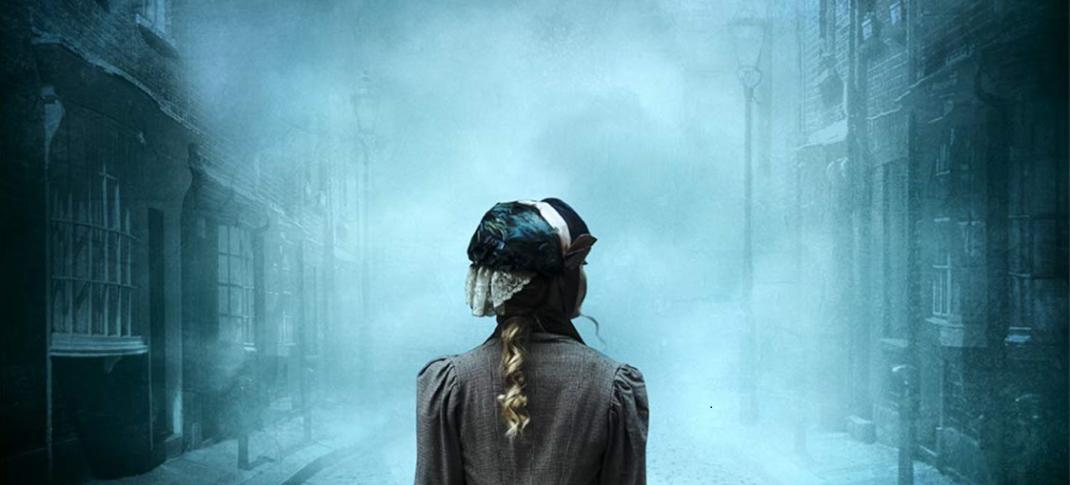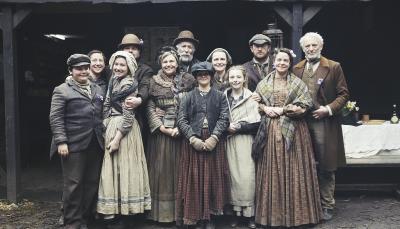Hallie Rubenhold's 'The Five' Offers a New Perspective on Jack the Ripper

My intention in writing this book is not to hunt and name the killer. I wish instead to retrace the footsteps of five women, to consider their experiences within the context of their era, and to follow their paths through both the gloom and the light. They are worth more to us than the empty human shells we have taken them for; they were children who cried for their mothers, they were young women who fell in love; they endured childbirth, the death of parents; they laughed, and they celebrated Christmas. They argued with their siblings, they wept, they dreamed, they hurt, they enjoyed small triumphs. Hallie Rubenhold, author of The Five: The Untold Lives of the Women Killed by Jack the Ripper.
“They’re answers in a pub quiz and that’s wrong. I found it beyond injustice that these women were defined solely by the way they died, while their killer was elevated to mythology.” Ian Bell, composer of the opera Jack the Ripper: The Women of Whitechapel.
Polly Nichols, Annie Chapman, Elisabeth Stride, Kate Eddowes, and Mary Jane Kelly: You may not know their names, but you know who they are. They are the victims of one of the most famous - and most often obsessed over - serial killers in history. A man known only as Jack the Ripper.
And history can no longer write these women off, at best as prostitutes, at worst as women who somehow deserved their fate. Most of them weren’t young, they weren’t sexy, and poverty and disease had destroyed any earlier prettiness they may have possessed. Mary Jane Kelly, in her late twenties, was the youngest. And their stories deserve to be told.
Now, over a century after their deaths, they are.
An opera called The Women of Whitechapel premiered earlier this year in London, which focused on the lives of these same women, and author Hallie Rubenhold published The Five: The Untold Lives of the Women Killed by Jack the Ripper. This book is an engrossing and illuminating account of their lives: Rubenhold barely mentions the Ripper in the text, and does not relate the gruesome details of their deaths, or attempt to analyze the police and inquest records, many of which are lost and those remaining inaccurate or contradictory. Newspaper reports are even worse, relying at the time on sensationalism and hearsay—Fake News indeed. Instead Rubenhold turns to Poor Law and court records, family letters, and first-hand accounts of life in 1880s London to bring the five women to life.
If you watched PBS’s Victorian Slum House you may have some idea of what living conditions were like in late nineteenth-century London. But if you look into the history of the period, you’ll realize what a cleaned-up version of the era was presented. While our modern participants might have enjoyed some cosplay, they probably wouldn’t want to be authentically inflicted with vermin or disease and the psychological impact of a life of struggle. If you missed the series, and you're a PBS Passport member, you can watch the full episodes online.
Middle-class reformers were shocked by living conditions in Whitechapel, regarded as the worst slum in the city. William Booth, founder of the Salvation Army, surveyed the poor of the city and published his findings in 17 volumes in 1891. He included a London poverty map, color-coded, which included 100,000 chronic poor as the lowest category shown in black. Typically "employed" as occasional labourers, street sellers, loafers, criminals and semi-criminals, these inhabitants of Whitechapel and other “black” areas were regarded as beyond redemption. Booth proposed breaking up these communities and dispersing their numbers around the city. Others suggested emigration to Canada or Australia, or forced sterilization.

The American philanthropist George Peabody was the first to recognize that economics and high rents created the problems of the poor in his beloved adoptive city, and he had the means to do something about it. He created a huge endowment to provide suitable housing where tenants—naturally of good character and hard workers—could live in comfort with indoor plumbing, laundry facilities on the premises, and enough room to provide privacy for a family.
Similar housing, portrayed in the foruth episode of Victorian Slum House, was provided later by the LCC (London City Council), but as with earlier noble efforts, the poor themselves were not consulted and this grand social experiment didn't work too well.
Ripper victim Polly Nicholls lived in one of Peabody's properties, the Stamford Street Estate, for a time. The Peabody Trust still exists, working to provide affordable housing in London.

London, like many other major cities of the time, presented great contrasts. It was possible to go from an area of grand houses to terrible slums within minutes. Rubenhold begins her book in 1887, the year of Queen Victoria’s Jubilee, when, as the history books would like us to believe, the whole country celebrated fifty years of peace, prosperity, and Empire.
But those sleeping rough in Trafalgar Square, the geographical dividing point between the rich of the West End and the poverty of the East End, had little to celebrate. In November, a violent clash between 2,000 police and the military and 40,000 demonstrators took place. One of the women arrested there was Nichols, whose life was to end less than a year later as the Ripper’s first (known) victim.

This was an age when poverty and addiction were seen as character flaws. We now acknowledge the problem wasn’t impaired morality but the result of drought, a financial depression, and low wages. There was no safety net, and any assistance offered, such as a stay in the dreaded Workhouse, came with degradation, shame, and frequently danger. Alcohol offered a soothing escape.
The Five all came from poor backgrounds but the factors linking their lives, other than their deaths, were alcoholism, homelessness, and isolation. They were women struggling to survive in the harshest of times and place, yet after their deaths they were written off as prostitutes, a definition Rubin seeks to disprove.
Admittedly, both Mary Jane Kelly and Elisabeth Stride were, or had been, sex workers. Mary Jane had a gift for tall tales of a glamorous past, including exploits of life as an expensive West End prostitute. But Elisabeth Stride discovered it was the only path possible for her once she was abandoned and pregnant by an unknown protector in her native Sweden. Thanks to repressive Swedish laws, any woman who had a relationship outside of wedlock or evidence of sexual activity was classified as a prostitute, and subject to demeaning medical examinations and strict rules of conduct.
London, like many other major English cities, wasn’t much better. The odds were stacked against these women from the outset and they are still being judged by Victorian standards. Even the police couldn’t decide on how to identify a prostitute, although they tried. Was a woman on her own a sex worker? A woman without a hat or jacket? Ludicrously during the official inquests surrounding the victims, which provide some reasonable evidence, the term “walking the streets” was mistakenly applied to a description of a woman, literally, out on her own and walking in the street. It was acknowledged at the time that neither Polly Nicholls nor Annie Chapman were ever sex workers, but by then the idea had taken hold
The Five all found themselves alone, either too ashamed, too drunk, or too embarrassing for their families to continue a normal relationships with them. Life is hard enough for families of addicts now, even with a greater understanding of the nature of the disease. The Five were condemned by would-be reformers and the Press (on behalf of its middle-class readers) for forming relationships out of wedlock with other men, but it was a practical means to survive. The working-class couldn’t afford to be too scrupulous about marital status, with divorce and certainly remarriage being financially and socially out of reach.
A woman alone on the streets was vulnerable. Teaming up with a male partner for protection made sense if she couldn’t afford to stay in one of the city’s hellishly squalid boarding houses (he might even pay for the bed), or hated the idea of the degradation of the Workhouse. As Rubenhold says:
[Mary Jane Kelly] had experienced the degradation of the workhouse, the general disgust of society, and had grown acquainted with starvation and illness. Under such circumstances, what mattered most was the here and now: getting the drink that dulled the pain and the food that stopped the hunger. John Kelly’s company, his protection on the street, and his occasional income made life easier. For a woman who had so little, this in itself would have proven comfort enough.
A single woman of any class, at almost any income level, was a threat to the status quo, particularly when combined with vagrancy, public drunkenness, and sporting tattoos (Kate Eddowes and her lover Thomas Conway both had tattoos of each other’s initials, something associated with the lowest elements of society).
Certainly, the Five made terrible mistakes and had frequent lapses of judgment—they were by no means saints, but human beings struggling to survive. Rubenhold incidentally comes up with a simple, sensible explanation of why and how the Ripper chose his victims—he preyed on women asleep. So there is no sinister plot. The Ripper was probably not a surgeon, butcher, aristocrat, Jew, sailor, foreigner, member of the Royal Family, or the artist Walter Sickert (yes, we’re looking at you, Patricia Cornwell), and almost certainly not Dracula. One sad side effect of the sensationalist speculation and irresponsible news reporting—and this again is something that is all too familiar—was that racial divides and anti-semitism were inflamed as people panicked, demanded action, and formed vigilante groups.
Rubenhold has succeeded admirably in restoring humanity to her victims, and the book is an absorbing and intelligent read. She concludes:
The courses their lives took mirrored that of so many other women of the Victorian age, and yet were so singular in the way they ended. It is for them that I write this book. I do so in the hope that we may now hear their stories clearly and give back to them that which was so brutally taken away with their lives: their dignity.
Have you read this book yet? Did you know anything about the Five? Or do you have any favorite theories about the identity of Jack the Ripper? Let's discuss in the comments.



